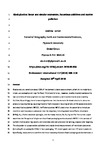Black plastics: Linear and circular economies, hazardous additives and marine pollution.
| dc.contributor.author | Turner, Andrew | |
| dc.date.accessioned | 2018-05-31T12:49:14Z | |
| dc.date.issued | 2018-08-01 | |
| dc.identifier.issn | 0160-4120 | |
| dc.identifier.issn | 1873-6750 | |
| dc.identifier.uri | http://hdl.handle.net/10026.1/11609 | |
| dc.description.abstract |
Black products constitute about 15% of the domestic plastic waste stream, of which the majority is single-use packaging and trays for food. This material is not, however, readily recycled owing to the low sensitivity of black pigments to near infrared radiation used in conventional plastic sorting facilities. Accordingly, there is mounting evidence that the demand for black plastics in consumer products is partly met by sourcing material from the plastic housings of end-of-life waste electronic and electrical equipment (WEEE). Inefficiently sorted WEEE plastic has the potential to introduce restricted and hazardous substances into the recyclate, including brominated flame retardants (BFRs), Sb, a flame retardant synergist, and the heavy metals, Cd, Cr, Hg and Pb. The current paper examines the life cycles of single-use black food packaging and black plastic WEEE in the context of current international regulations and directives and best practices for sorting, disposal and recycling. The discussion is supported by published and unpublished measurements of restricted substances (including Br as a proxy for BFRs) in food packaging, EEE plastic goods and non-EEE plastic products. Specifically, measurements confirm the linear economy of plastic food packaging and demonstrate a complex quasi-circular economy for WEEE plastic that results in significant and widespread contamination of black consumer goods ranging from thermos cups and cutlery to tool handles and grips, and from toys and games to spectacle frames and jewellery. The environmental impacts and human exposure routes arising from WEEE plastic recycling and contamination of consumer goods are described, including those associated with marine pollution. Regarding the latter, a compilation of elemental data on black plastic litter collected from beaches of southwest England reveals a similar chemical signature to that of contaminated consumer goods and blended plastic WEEE recyclate, exemplifying the pervasiveness of the problem. | |
| dc.format.extent | 308-318 | |
| dc.format.medium | Print-Electronic | |
| dc.language | en | |
| dc.language.iso | en | |
| dc.publisher | Elsevier | |
| dc.subject | Black plastic | |
| dc.subject | Brominated flame retardants | |
| dc.subject | Food packaging | |
| dc.subject | Heavy metals | |
| dc.subject | Recycling | |
| dc.subject | Waste electrical and electronic equipment | |
| dc.title | Black plastics: Linear and circular economies, hazardous additives and marine pollution. | |
| dc.type | journal-article | |
| dc.type | Journal Article | |
| dc.type | Review | |
| plymouth.author-url | https://www.ncbi.nlm.nih.gov/pubmed/29778831 | |
| plymouth.volume | 117 | |
| plymouth.publication-status | Published | |
| plymouth.journal | Environment International | |
| dc.identifier.doi | 10.1016/j.envint.2018.04.036 | |
| plymouth.organisational-group | /Plymouth | |
| plymouth.organisational-group | /Plymouth/Faculty of Science and Engineering | |
| plymouth.organisational-group | /Plymouth/Faculty of Science and Engineering/School of Geography, Earth and Environmental Sciences | |
| plymouth.organisational-group | /Plymouth/REF 2021 Researchers by UoA | |
| plymouth.organisational-group | /Plymouth/REF 2021 Researchers by UoA/UoA07 Earth Systems and Environmental Sciences | |
| plymouth.organisational-group | /Plymouth/Research Groups | |
| plymouth.organisational-group | /Plymouth/Research Groups/BEACh | |
| plymouth.organisational-group | /Plymouth/Research Groups/Marine Institute | |
| plymouth.organisational-group | /Plymouth/Users by role | |
| plymouth.organisational-group | /Plymouth/Users by role/Academics | |
| dc.publisher.place | Netherlands | |
| dcterms.dateAccepted | 2018-04-20 | |
| dc.rights.embargodate | 2019-5-17 | |
| dc.identifier.eissn | 1873-6750 | |
| dc.rights.embargoperiod | 12 months | |
| rioxxterms.versionofrecord | 10.1016/j.envint.2018.04.036 | |
| rioxxterms.licenseref.uri | http://www.rioxx.net/licenses/under-embargo-all-rights-reserved | |
| rioxxterms.licenseref.startdate | 2018-08-01 | |
| rioxxterms.type | Journal Article/Review |


